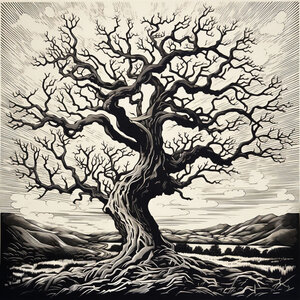Printmaking
|
|
Printmaking is a process for producing a work of art in ink; the work (called a "print") is created indirectly, through the transfer of ink from the surface upon which the work was originally drawn or otherwise composed. The artist determines how many prints are to be made in an edition, usually signing and numbering each one (and sometimes separately producing one or more artist's proofs. Depending on the complexity of the process chosen, the artist may work in conjunction with an expert printmaker, and make use of a printing press, a baren, a brayer, and/or a squeegee.
Surfaces used in printmaking include planks of wood, metal plates, flat stones, or a porous fabric mesh stretched in a frame. Small prints can even be made using the surface of a potato.
| Contents |
Techniques
The four most popular printmaking techniques are woodcut, etching, lithography, and screen-printing. Other printmaking techniques include [[chine-coll靝, collography, monotyping, engraving, drypoint, mezzotint, linocut, aquatint and batik. These techniques can also be combined.
Woodcut
Woodcut, a type of relief print, is thought to be the earliest printmaking technique, dating back to 9th century China. The artist draws a sketch on a plank of wood and then uses sharp tools to carve away the parts of the block that he/she does not want to receive the ink. The raised parts of the block are inked with a brayer, then a sheet of paper, perhaps slightly damp, is placed over the block. The block is then rubbed with a baren or spoon, or is run through the press.
Separate blocks are used for each color.
Artists using this technique include Georg Baselitz, Willie Cole Helen Frakenthaler, Paul Gauguin, Erich Heckel, Horst Janssen, Ernst Ludwig Kirchner, Frans Masereel, Edvard Munch, Emil Nolde, A.R. Penck, Margaret Preston Olga Rozanova, and Joel Shapiro.
Etching
Etching is part of the intaglio family (along with engraving, drypoint, mezzotint, and aquatint.) Etching prints are generally linear and often contain fine detail and contours. Lines can vary from smooth to sketchy. A waxy acid-resist, known as a ground, is applied to a metal plate, most often copper. After the ground has dried the artist uses a sharp tool to scratch into the ground, exposing the metal. The plate is then completely submerged in an acid that eats away at the exposed metal. This process is known as biting. The waxy resist protects the acid from biting the parts of the plate that have not been scratched into. The longer the plate remains in the acid the deeper the incisions become. The plate is removed from the acid and the ground is removed with a solvent such as turpentine. The entire plate is inked. A wad of cloth is often used to push the ink into the incised lines. An etching is opposite of a woodcut in that the raised portions of an etching remain blank while the crevices hold ink. The surface is wiped clean with a piece of stiff fabric known as tarlatan or newsprint paper. The wiping leaves ink only in the incisions. A damp piece of paper is placed over the plate and it is run through the press. Artists using this technique include Jim Dine, Otto Dix, James Ensor, Lucian Freud, Paul Klee, Edward Hopper, Horst Janssen, K䴨e Kollwitz, Mauricio Lasansky, Brice Marden, Henri Matisse, Giorgio Morandi, Pablo Picasso, and Cy Twombly.
Lithography
Lithography is a technique invented in 1798 by Alois Senefelder and based on the chemical repulsion of oil and water. A porous surface, normally limestone, is used; the image is drawn on the limestone with an oily medium. Acid is applied, transferring the oil to the limestone, leaving the image 'burned' into the surface. Gum arabic, a water soluble substance, is then applied, sealing the surface of the stone not covered with the drawing medium. The stone is wetted, with water staying only on the surface not covered in oil-based residue of the drawing; the stone is then 'rolled up', meaning greasy ink is applied with a roller covering the entire surface; since water repels the grease in the ink, the ink adheres only to the oily parts, perfectly inking the image. A sheet of wet paper is placed on the surface, and the image is transferred to the paper by the pressure of the printing press. Lithography is known for its ability to capture fine gradations in shading and very small detail.
A variant is photo-lithography, in which the image is captured by photographic processes on metal plates; printing is carried out in the same way. </div> Artists using this technique include George Bellows, Pierre Bonnard, Vija Clemins, Stuart Davis, Ellsworth Kelly, Willem de Kooning, [[Joan Mir Edvard Munch, Emil Nolde, Elizabeth Peyton, Pablo Picasso, Odilan Redon, Henri de Toulouse-Lautrec, and Terry Winters,
Screen-printing
Screen-printing (also known as "silk-screening" or "serigraphy") creates bold color using a stencil technique. The artist draws an image on a piece of paper or plastic film can also be used.) The image is cut out creating a stencil. (Keep in mind the pieces that are cut away are the areas that will be colored.) A screen is made of a piece of fabric (originally silk) stretched over a wood frame. The stencil is affixed to the screen. The screen is then placed on top of a piece of dry paper or fabric. Ink is then placed across the top length of the screen. A squeegee (rubber blade) is used to spread the ink across the screen, over the stencil, and onto the paper/fabric. The screen is lifted and the image is now transferred onto the paper/fabric. Each color requires a separate stencil. The screen can be re-used after cleaning.
Josef Albers, Chuck Close, Ralston Crawford, Robert Indiana, Roy Lichtenstein, Julian Opie, Blinky Palermo, Bridget Riley, Edward Ruscha, and Andy Warhol.

